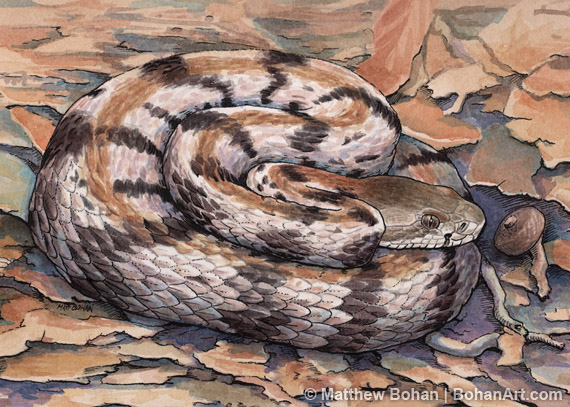Timber Rattler in Oak Leaves Watercolor and Ink Step-by-step
This is another watercolor and ink. It has been interesting to try and develop a second style of painting. I think trying to strip things down has been good for me and encouraged more bold color use. They seem to have a nice energy about them and, at least to my eye, don’t seem “stiff.”
While working on this painting I kept thinking about a few people. As a child there was a man at our church who my parents called the “Snake Doctor.” At first I was confused by this, imagining the guy holding a stethoscope up to an anaconda. I figured it out eventually. The subtleties between PhD and MD degrees were lost on a 6 year old. Many years later I ended up taking Herpetology from the Snake Doctor while in graduate school. Doc Bothner was an outgoing guy with an endless supply of hilarious stories and quotable one-liners. I taught a few labs for him, and we spent a lot of time in the woods looking for herps, but we never found a timber rattler.
The second person who kept coming to mind while working on this was Dan, a great friend who was my housemate during grad school. He had a bunch of snakes in our apartment. (When I was looking for a place to live in Ann Arbor, one of the professors who knew Dan suggested him as a housemate. He qualified it by adding, “There is one thing though… Dan has a lot of snakes.” That probably was a deal-breaker for most people, but it was a bonus for me!)
Somewhere along the line Dan had collected a gravid watersnake to photograph. Eventually the snake had cute little babies—twelve, if I remember correctly! A week or two later I came home for lunch and was using the bathroom when I spied something slithering on the bathroom floor. Two of the watersnakes were roaming around the bathroom. The tank they were supposed to be in always kept the big snakes contained, but the tiny guys found their way out. I put them back in the tank and went about making my lunch. For some reason I got in the habit of counting the baby snakes after that. I could imagine pouring out my corn flakes in the morning and having a wiggling snake in there.
The third person who was on my mind was my mother-in-law Merritt. We came across this timber rattler while on a hike with her. She is easily one of the biggest nature lovers I’ve ever met, with an enthusiam for all things wild.
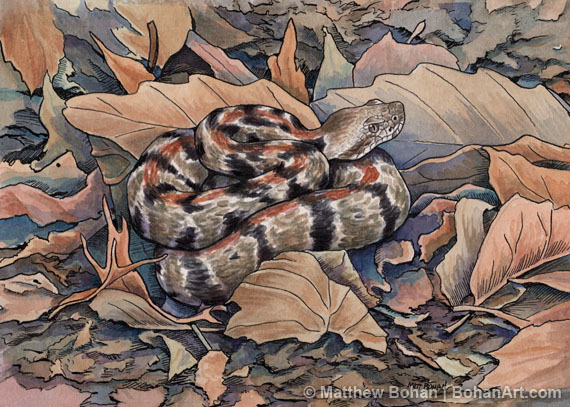

Original Available.
Prints are also available here.
Scarlet Tanager & Cherry Blossoms Transparent Watercolor and Ink Step-by-step
Our children are very absorbed in the natural world. They adore pretty much every thing furry, feathered and scaled that you can imagine coming across. I’m also very proud that they aren’t turned off by the creepy crawly things that most people avoid. They do hate ticks and mosquitos, but I consider that to be a sign that they still have their wits about them.
We often pause our home schooling when good birds come by the feeders or visit our yard. Last spring our ten year old looked up from her math and said, “SCARLET TANAGER!” We have seen them in the woods nearby but never in the yard. I was a little skeptical, but sure enough, right outside our kitchen window on the cherry tree was a gorgeous male. Fortunately, the camera was right nearby to get some shots. It made appearances here and there for few days before disappearing.
It used to be that my wife and I were always pointing out birds and identifying them for the kids. Now they are returning the favor, pointing out tons of things we would’ve missed otherwise. They don’t always know if it is a Cooper’s or a sharp-shinned hawk in the backyard, but hey, I can’t always tell at a quick glance either! The best thing is seeing the excitement in their eyes when they get a good find.
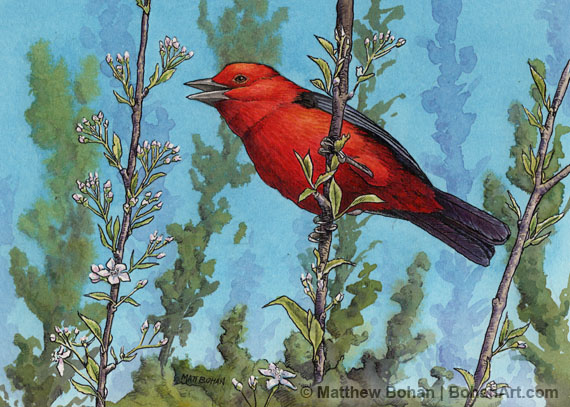

Original painting is available here.
Soldier Beetle Pencil Drawing (New Sketchbook Page 1)
Finishing a sketchbook is always a big event for me. I use bound sketchbooks and NEVER tear the pages out. It’s kind of a big deal to me to try and have quality sketches throughout the whole book without any lemons. Starting a new sketchbook is stressful. I really sweat over the first drawing because it sets the tone for the entire book. Once I get the first drawing out of the way I can enjoy myself again.
I was unable to find the exact type of sketchbooks that I have been using for over 10 years and had to find a close approximation. I started on the first sketch while waiting for the kids in karate. I discovered the paper was much more abrasive than the previous sketchbooks, so this might take a little getting used to. For no particular reason, I started with a soldier beetle that I took photos of over the summer. Perhaps it would’ve been more appropriate to start with a bird since that has been my obsession for ages, but I have a fondness for insects as well, so why not.
Once I had the sketch finished, I was a quite relieved that the initial sketch went over decently! Now I just need to finish the whole book, which is about 200 pages.
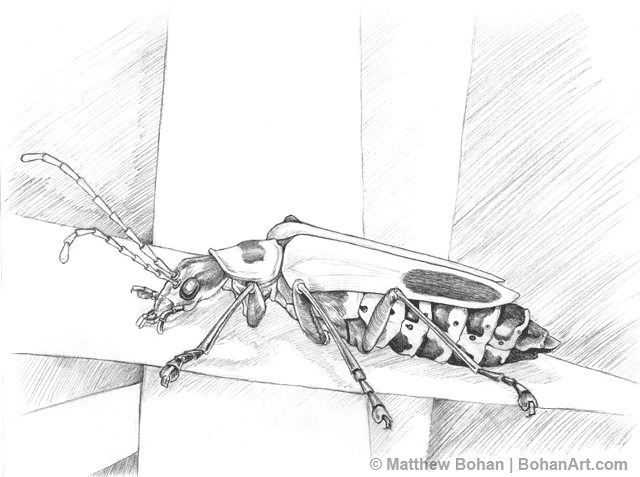
Winter Ruddy Turnstone Transparent Watercolor and Ink (Step-by-step)
Ruddy turnstones like to walk along the surf’s edge, flipping over rocks and shells looking for dinner. I’m not sure what they find appetizing under there, but I wouldn’t want to eat it. The ruddy turnstone is currently classified with sandpipers, but in the past it was placed in the plover family. I guess ornithologists need something to argue about. Turnstones do seem to share some outward characteristics with both families.
Although they are pretty common, I don’t see these birds very often. Having spent little time along the coasts, I have a fairly large gap in my life list. I’ve come across them in various states from New York to Florida, but have observed these handsome birds in peak summer plumage only a handful of times. I chose to paint this one in its drab winter plumage since that is what I know best. At some point I’ll have to paint one in its “full glory.”
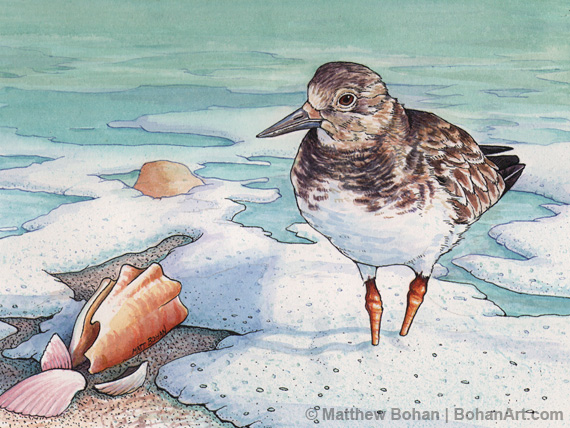

Female Twelve-spotted Skimmer Dragonfly Transparent Watercolor Step-by-step
Being a bird fanatic, spring is always an exciting time of year. You get a huge volume of birds moving through the area. Once the migrants move off to their Northern breeding grounds, you are left with just the normal breeding birds in your area. The birding also slows down as thick summer foliage makes the birds harder to observe. That can be a bit of a let-down.
Fortunately, the natural world always has something great in store. The insect world bursts to life in the summer. Damselflies and dragonflies might not have the great public relations of the butterflies, but they are just as spectacular. The twelve-spotted skimmer is a common dragonfly, but is visually striking. It is one of the easier dragonflies to identify. Females, like the one in this painting, lack the strong white wing markings of the males.
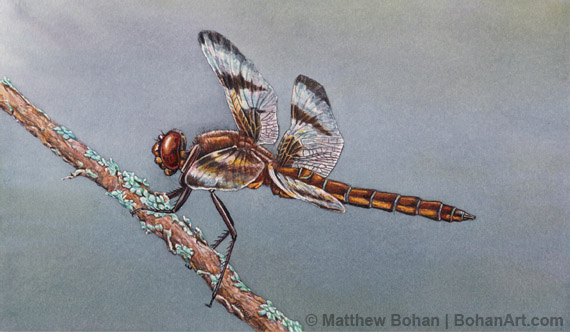
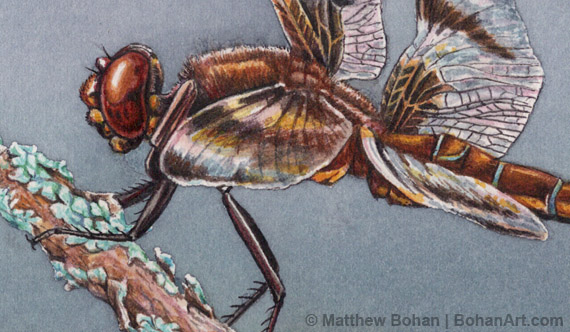
Baltimore Oriole and Redbud Transparent Watercolor & Ink Step-by-Step
Who doesn’t like a bright orange bird? I thought this would make for a fast, fun painting using some quick washes and ink.
We are lucky to have Baltimore orioles visiting our feeders from May until September. I hollowed out a few logs so I could drop in small containers of grape jelly. They are easy to clean and it allows me to observe the birds and get photos of them on natural objects rather than a conventional man made feeders. I also can move the feeder around to get it in better light or against a nice background. I never get tired of watching these spectacular birds.
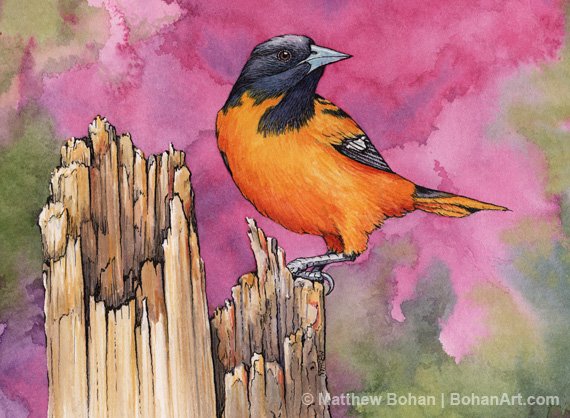
Snapping Turtle Pencil Sketch
I’ve always enjoyed coming across common snapping turtles. I still remember seeing one for the first time on a canoe trip in Western NY and thinking it was scary and prehistoric. I was told by an adult on the trip that they can “bite your finger clean off in the blink of an eye.” That adult “turtle expert” was poking the thing with a stick at the time. He insisted that they can bite broomsticks in half. The poor turtle tried to pull its head back in, hissed a bit and showed off it’s mouth, giving a ton of warning. Eventually after much molesting, it bit at the stick. Although much smaller than a broomstick it did not break it in half.
Kids do need to know not to handle snapping turtles. Without respect they can send you to the hospital. I’m pretty sure that poking the thing in the face with a stick is NOT the best teaching technique, although it might be the most commonly used. I left the experience a little baffled. The turtle seemed scary, mostly because of what the adult said. Of the two, the turtle seemed much better behaved than the human. At least it wasn’t the aggressor in the confrontation.
Since I spend a lot of time on bikes I come across a few of these each year trying to cross the road, usually females in early June looking for a place to lay their eggs. I always stop and move them out of the road so they don’t get flattened. I get some strange looks from people, especially if it is a big heavy female (the turtle that is). No doubt they have heard that they are blood thirsty villains waiting to bite your fingers off. I learned how to properly handle snapping turtles while taking Herpetology in grad school. I wouldn’t suggest trying to pick one up unless you know exactly what you are doing and have fast hands. The worst experience I’ve had handling turtles is getting scratched by their claws… and I’ve gotten much worse from house cats.
They do have a sharp and powerful tomium (beak) that can do serious damage. Snappers can move VERY quickly, and their neck is incredibly flexible. They should be respected, but not necessarily feared. I’m not saying that they are the nicest creatures in the world. They are incredibly efficient predators. I’d watched snapping turtles eat ducks and geese, and they make short work of it.
Our neighbors found this smallish snapper in their yard while gardening. I took a bunch of photos and released it at a nearby pond.

Marbled Orb Weaver Pencil Sketch
Finding these beautiful spiders is always a treat. This one built a big web in a clematis. It had a “house” that it stitched together out of leaves and silk to hide in by day. It took a week to find it out of its shelter and get some good photos to work from.
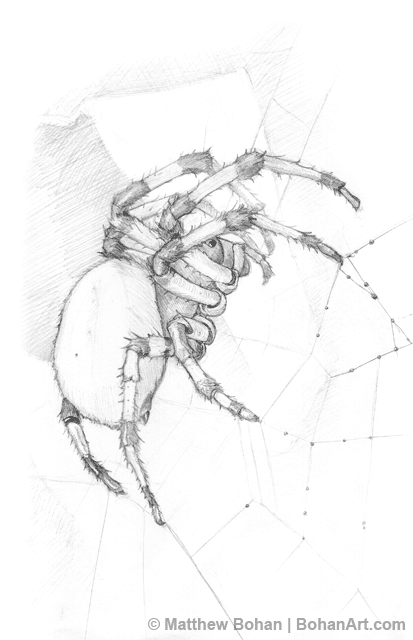
American Goldfinch Transparent Watercolor and Ink
American goldfinches are cheery birds. I thought I’d try out a really quick watercolor and ink of this male.
Original painting is available here.
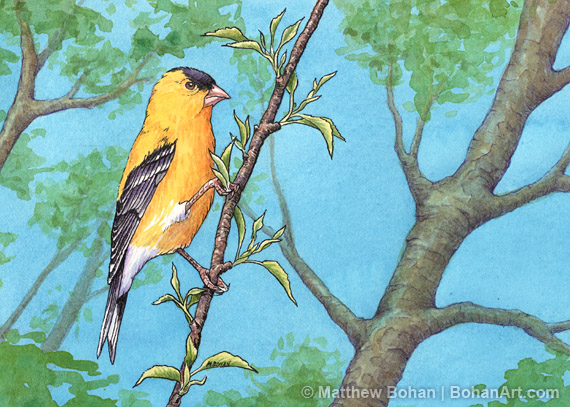
Timber Rattler Watercolor and Ink
This is a Tennessee Timber rattler that we discovered near my Mother-in-law’s house. I thought it would be worth trying as a “faster” watercolor and ink painting. I’m not sure if the subject matter didn’t lend itself to the medium as well, or if I’m still getting used to inking over a sped up painting… perhaps both. In the end I like it, but don’t think it is the strongest work in the portfolio.
